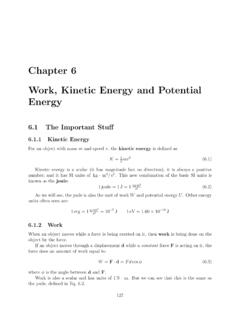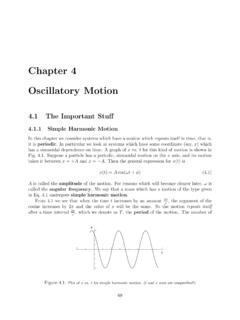Transcription of Chapter 3 Motion in Two and Three Dimensions
1 Chapter 3 Motion in Two and Three The Important PositionIn Three Dimensions , the location of a particle is specified by itslocation vector, r:r=xi+yj+zk( )If during a time interval tthe position vector of the particle changes fromr1tor2, thedisplacement rfor that time interval is r=r1 r2( )= (x2 x1)i+ (y2 y1)j+ (z2 z1)k( ) VelocityIf a particle moves through a displacement rin a time interval tthen its average velocityfor that interval isv= r t= x ti+ y tj+ z tk( )As before, a more interesting quantity is theinstantaneousvelocityv, which is the limitof the average velocity when we shrink the time interval tto zero.
2 It is the time derivativeof the position vectorr:v=drdt( )=ddt(xi+yj+zk)( )=dxdti+dydtj+dzdtk( )can be written:v=vxi+vyj+vzk( )5152 Chapter 3. Motion IN TWO AND Three Dimensions wherevx=dxdtvy=dydtvz=dzdt( )The instantaneous velocityvof a particle is always tangent to the path of the AccelerationIf a particle s velocity changes by vin a time period t, the average accelerationaforthat period isa= v t= vx ti+ vy tj+ vz tk( )but a much more interesting quantity is the result of shrinking the period tto zero, whichgives us the instantaneous acceleration,a. It is the time derivative of the velocity vectorv:a=dvdt( )=ddt(vxi+vyj+vzk)( )=dvxdti+dvydtj+dvzdtk( )which can be written:a=axi+ayj+azk( )whereax=dvxdt=d2xdt2ay=dvydt=d2ydt2az=d vzdt=d2zdt2( ) Constant Acceleration in Two DimensionsWhen the accelerationa(for Motion in two Dimensions ) is constant we have two sets ofequations to describe thexandycoordinates, each of which is similar to the equations inChapter 2.
3 (Eqs. ) In the following, Motion of the particle begins att= 0; theinitial position of the particle is given byr0=x0i+y0jand its initial velocity is given byv0=v0xi+v0yjand the vectora=axi+ +axtvy=v0y+ayt( )x=x0+v0xt+12axt2y=y0+v0yt+12ayt2( )v2x=v20x+ 2ax(x x0)v2y=v20y+ 2ay(y y0)( )x=x0+12(v0x+vx)ty=y0+12(v0y+vy)t( )Though the equations in each pair have the sameformthey are not identical because thecomponents ofr0,v0andaare not the THE IMPORTANT Projectile MotionWhen a particle moves in a vertical plane during free fall its acceleration is constant; theacceleration has magnitude is directed downward.
4 If its coordinates are given bya horizontalxaxis and a verticalyaxis which is directed upward, then the acceleration oftheprojectileisax= 0ay= g( )For a projectile, the horizontal accelerationaxis zero!!!Projectile Motion is a special case of constant acceleration, so we simply use Eqs. , with the proper values Uniform Circular MotionWhen a particle is moving in a circular path (or part of one) atconstant speedwe say thatthe particle is inuniform circular Motion . Even though the speed is not changing,theparticle is acceleratingbecause its velocityvis acceleration of the particle is directed toward the center of the circle and has mag-nitudea=v2r( )whereris the radius of the circular path andvis the (constant) speed of the of the direction of the acceleration ( toward the center), we say that a particlein uniform circular Motion has acentripetal the particle repeatedly makes a complete circular path, then it is useful to talk aboutthe timeTthat it takes for the particle to make one complete trip around the circle.
5 Thisis called theperiodof the Motion . The period is related to the speed of the particle andradius of the circle by:T=2 rv( ) Relative MotionThe velocity of a particle depends on who is doing the measuring; as we see later on it isperfectly valid to consider moving observers who carry their own clocks and coordinatesystems with them, they make measurements according totheir ownreference frame;that is to say, a set of Cartesian coordinates which may be in Motion with respect to anotherset of coordinates. Here we will assume that the axes in the different system remain parallelto one another; that is, one system can move (translate) but notrotatewith respect toanother observers in framesAandBmeasure the position of a pointP.
6 Then then ifwe have the definitions:rP A= position ofPas measured byArP B= position ofPas measured byB54 Chapter 3. Motion IN TWO AND Three DIMENSIONSrBA= position ofB s origin, as measured byAwithv s anda s standing for the appropriate time derivatives, then we have the relations:rP A=rP B+rBA( )vP A=vP B+vBA( )For the purposes of doing physics, it is important to consider reference frames which moveatconstant velocitywith respect to one another; for these cases,vBA= 0 and then we findthat pointPhas the same acceleration in these reference frames:aP A=aP BNewton s Laws (next Chapter !) apply to such a set ofinertial reference frames.
7 Observersin each of these frames agree on the value of a particle s the above rules for translation between reference frames seem very reasonable, itwas the great achievement of Einstein with his theory ofSpecial Relativityto understandthe more subtle ways that we must relate measured quantitiesbetween reference frames. Thetrouble comes about because time (t) isnotthe same absolute quantity among the other places, Eq. is used in problems where an object like a plane or boathas a known velocity in the frame of (with respect to) a mediumlike air or water whichitselfis moving with respect to the stationary ground; we can then find the velocity of the planeor boat with respect to thegroundfrom thevector sumin Eq.
8 Worked Velocity1. The position of an electron is given by r= + (wheretis inseconds and the coefficients have the proper units for r to be inmeters). (a)What is v(t)for the electron? (b) In unit vector notation, what is v att= s?(c) What are the magnitude and direction of v just then?[HRW5 4-9](a)The velocity vectorvis the time derivative of the position vectorr:v=drdt=ddt( + )= we mean that whentis in seconds,vis given WORKED EXAMPLES55(b)Att= s, the value ofvisv(t= s) = ( )( )j= is, the velocity is ( )ms.(c)Using our answer from (b), att= s the magnitude ofvisv= v2x+v2y+v2z= ( )2+ ( )2+ (0)2= note that the velocity vector lies in thexyplane (even though this is a Three dimensionalproblem!)
9 So that we can express its direction with a single angle, the usual angle measuredanti-clockwise in thexyplane from thexaxis. For this angle we get:tan =vyvx= = tan 1( ) = 79 .When we take the inverse tangent, we should always check and see if we have chosen theright quadrant for . In this case 79 iscorrect sincevyis negative andvxis Acceleration2. A particle moves so that its position as a function of time in SI units isr=i+ 4t2j+tk. Write expressions for (a) its velocity and (b) its acceleration asfunctions of time.[HRW5 4-11](a)To clarify matters, what we mean here is that when we use the numerical value oftinseconds, we will get the values ofrinmeters.
10 Since the velocity vector is the time derivativeof the position vectorr, we have:v=drdt=ddt(i+ 4t2j+tk)= 0i+ 8tj+kThat is,v= 8tj+k. Here, we mean that when we use the numerical value oftin seconds,we will get the value ofvinms.(b)The accelerationais the time derivative ofv, so using our result from part (a) we have:a=dvdt=ddt(8tj+k)= 8j56 Chapter 3. Motion IN TWO AND Three DIMENSIONSSoa= 8j, where we mean that the value ofais in units ofms2. In fact, we should reallyinclude the unitshereand write:a=(8ms2)j3. A particle moving with an initial velocity v= (50ms)j undergoes an accelerationa= [35 m/s2+ (2 m/s5)t3)i+ [4 m/s2 (1 m/s4)t2]j.]















